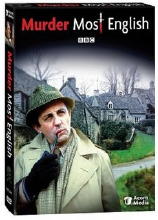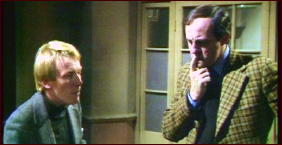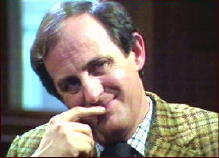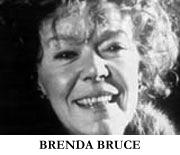Sun 14 Jun 2009
TV Review: MURDER MOST ENGLISH: A FLAXBOROUGH CHRONICLE (1977).
Posted by Steve under Reviews , TV mysteries[9] Comments
MURDER MOST ENGLISH: A FLAXBOROUGH CHRONICLE. TV series: BBC, 1977. Anton Rodgers (Detective Inspector Purbright), Christopher Timothy (Detective Sergeant Love), John Comer (Sergeant Malley), Moray Watson (Chief Constable Chubb).

â— Hopjoy Was Here. May 8 & May 15, 1977. John Normington, Lynn Farleigh, Gary Watson, Michael Robbins. Based on the novel by Colin Watson; screenplay: Richard Harris. Director: Ronald Wilson.
â— Lonelyheart 4122. May 15 & May 22, 1977. Brenda Bruce (Lucy Teatime), John Carson, Gillian Martell, Erin Geraghty. Based on the novel by Colin Watson; screenplay: Richard Harris. Director: Ronald Wilson.
In the seven episodes of this (alas) short-lived series, a total of four of Colin Watson’s “Flaxborough” mysteries were adapted. So far I’ve watched only the two above. The other two are:
â— The Flaxborough Crab. May 29 & June 5, 1977.
â— Coffin Scarcely Used. June 12 & June 19, 1977.
… and both are on my “to be watched soon” list, although I’m not likely to review them here. (There are too many TV detective shows to be watched and too little time to report on them, I’m sorry to say, or rather I’m only sorry about the second part of that sentence.)

There is more wickedness going on in small villages, I believe Watson is trying to say — and successfully, too, as far as I’m concerned — than meets the eye, or the eye, that is to say, of the most cosmopolitan resident of London, Liverpool or any other large British city.
In Hopjoy Was Here, for example, a fellow named Hopjoy has disappeared and is most probably dead, his body most likely dissolved in acid and quietly disposed of down the bathtub drain. He was secretly working as an espionage agent for some hush-hush secret agency, and while two of his colleagues are working on their side of the tracks, Inspector Purbright is working quite another.
It is quite amusing to see the two agents flailing around in their darkness of broad daylight, while Purbright, who knows the countryside and the people who inhabit it, calmly smokes his pipe (most often in ugly plaid jackets that were quite the rage in the 1970s) and comes out far ahead of the game.

Not that the case doesn’t have its challenges. By the time the second installment began, I was sure I was far ahead of the good inspector, but he soon had caught up to me, only to … but I can’t tell you that.
The solution depends greatly on a working knowledge of people and their faults and foibles, and Purbright seems to a gentle, bucolic master of it, to the (sometimes perplexed) delight of his Chief Constable, and the dismay of Hopjoy’s fellow agents.
In Lonelyheart 4122, Purbright finds himself competing with another protagonist to solve the disappearance of two lonely women who had signed up for the same matrimonial service several months apart. Meet the very capable (and cigar-smoking) Lucy Teatime, who also seems to have designs on the killer — but for what reason?

Again you will have to watch to find out. The game of wits between Purbright and Miss Teatime is delightful, but the mystery itself is not nearly the challenge that was presented in Episode One, as the killer is quite obvious. Even so, there’s a kicker in the plot toward the end that I’m sure you will find quite satisfying.
And, oh yes, there’s one more thing. While the production values are of good television quality, they’re nowhere near as fine as even the most average movie. That doesn’t mean, though — and this is a big “though” — that you shouldn’t be watching every corner of the screen for small bits of business in the background.
This entails anything involving any of the other players, both those important to the plot and those really only incidentally in the scene, with a special mention going to Christopher Timothy as Detective Sergeant Love and his aversion to “human remains.” (He’s the one on the left in the second scene down.)
June 15th, 2009 at 11:42 am
As noted elsewhere here Lonelyheart 4122 was adapted as a made for television movie with Rosalind Russell, Douglas Fairbanks Jr., Maureen O’Sullivan, and Ross Martin called The Crooked Hearts. Moved to the US, it was Russell’s last film and a major disappointment with that cast. Russell played the Miss Teatime role and Martin the Purbright part, but other than curiosity there’s not much reason to seek it out.
Anton Rogers, who plays Purbright, is one of the more familiar faces in British film and television. You might remember him as the traitor in the film of Frederick Forsyth’s The Fourth Protocol or in a BBC comedy series May to December about a middle age man who falls in love with a younger woman.
June 15th, 2009 at 12:24 pm
In spite of your assessment of the Rosalind Russell TV movie, here’s another film I think I may *have* to try to track down.
Still, it doesn’t sound as though Ross Martin (as Sergeant Daniel Shine, not Inspector Purbright) as as great a role as in the book, according to a write-up on IMDB, so the rest of the story may also resemble it about as much — or in other words, not much at all.
— Steve
June 15th, 2009 at 1:05 pm
In the British television days before it seemed as if the work of almost every genre author was already in preparation for a small-screen adaptation before the ink had dried, it was somehow exhilerating to be introduced to a new TV presentation where the original author’s name didn’t end with Sayers, Wallace, Doyle or Christie. Van Gulik’s JUDGE DEE (ITV, 1969) was one. Household’s ROGUE MALE (BBC, 1976) was another. At the time, when the adaptation of the Colin Watson work was announced, it was reason enough for uncontained delight.
It was also taken as a note of particular interest that MURDER MOST ENGLISH represented the only television work related to Watson, even though he didn’t have a writing hand in it himself. Yet, for some thirty years it has remained a virtually unknown entity, offering a short run of only seven episodes, not led by any ‘great’ names, and with no notable TV re-runs to return it to public consciousness.
I was astonished to see Acorn Media bring it to DVD. Delighted, but still astonished.
This is of course what I have always believed that DVD excavation should be about – an opportunity for a wider audience to view, evaluate and perhaps discover for themselves.
Considering, then, little known entities, it may be of interest to see something of another English author of note with elusive TV credits: Peter O’Donnell. Outside the two squandered Modesty Blaise attempts to spark off a series of adventures (the 1982 pilot with Ann Turkel; the 2004 video/TV release with Alexandra Staden), television-sized work relating to O’Donnell remains scarce.
Fortunately, he did make a rare contribution to television by way of writing the six-part thriller serial TAKE A PAIR OF PRIVATE EYES (BBC, 10 April-15 May 1966), apparently a lightweight suspenser featuring a young couple who run an agency for the recovery of stolen property. It was produced by Alan Bromly, a BBC production veteran of countless Francis Durbridge serials from 1955. That may, indeed, herald a warning sign. The serial does still exist, although I’m fairly convinced that the b&w-period telerecording may end up being more of a disappointment than a discovery.
Still, if Acorn Media care to dig deep enough … who knows what curiosities may surface?
June 16th, 2009 at 1:19 am
The Modesty Blaise ABC television pilot with Ann Turkel (Mrs. Richard Harrison) somehow moved Modesty and Willie to the states and turned their British Secret Service contact Sir Gerald Tarrant into Keene Curtis. The best that can be said is that it wasn’t as awful as the Joesph Losey movie.
The good news about the 2004 film with Staden is that it was never meant to trigger a new series. Quentin Tarantino had the rights to the character but wasn’t ready to do the film he wanted to do, so to keep the rights he produced this little glimpse of Modesty’s past which takes her back to her early days when she foils a hold up of a casino she works in. Neither Willie nor Tarrant were in it. The primary reason for the film was to test Staden in the part and to keep his option on the character open. I haven’t seen it, but have read some positive reviews. It was never intended to have a major theatrical release, and only exists as part of a contractual obligation to allow Tarantino to hold onto the rights a bit longer.
Take a Pair of Private Eyes explains an odd book I read back in the mid sixties that had the tag ‘created by Peter O’Donnell’. It was apparently a novelization of this serial that was published over here as a straight novel. I can’t recall who wrote it, or even if that was the title, but it certainly is the plot and the time frame is right. Thanks for clearing up the mystery.
As for the backlog of old series we can only hope. I would love to see some of the Durbridge Paul Temple and Tim Frasier television serials regardless of quality and perhaps the John Gregson Gideon series, the Barry Foster Van der Valk, Sexton Blake, and the classic Rupert Davies Maigret. If Purbright made it there is surely some hope for the others. Hopefully the British industry wasn’t as cavalier with
these old shows as American studios were in the days before VHS and DVD.
Steve
Don’t put out too much effort finding The Crooked Hearts. It really is lame. Despite that sterling cast it has no spark and no pizzazz. After a while even the charm of seeing Fairbanks, O’Sullivan, and Russell on screen wears off and you are left with how bad the whole project is.
The only thing I can say about Ross Martin, is at least he is better here than he was as Charlie Chan.
This is one of those films that sounds as if it couldn’t miss — as if it might at least be worth while to watch old pros showing off their skills, and then it doesn’t even manage that. It might be tolerable if it were truly bad, in the way some bad films can be, but instead it is dull and worst of all misuses the talents involved who come off flat and utterly lacking in the charm they all possessed elsewhere. Frankly it’s one of the few films I’ve ever seen that left me angry that such talent and good material was so wasted.
But I’ll grant it sounds great in print. It’s just on the screen where it falls flat. Find out for yourself if you must, I certainly understand. It sounds as if it must at least be interesting when you hear it described, but a sorrier vehicle for such fine talent would be hard to find.
July 3rd, 2013 at 12:15 pm
Watching the DVD and it is fantastic – I’m 50 and have no recollection of the series, must have been doing or watching something else in 1977. Lovely to find these 35 years later!!
July 3rd, 2013 at 12:26 pm
1] Does anybody know in which real life town the Flaxborough Chrnicles were based and filmed ?
2] Why did the BBC only go for 7 episodes and leave it at that ?
July 18th, 2013 at 8:46 am
http://www.bostonstandard.co.uk/news/opinion/letters/letter-does-anyone-have-information-on-the-flaxborough-chronicles-1-5278453
July 18th, 2013 at 11:08 am
Ian
Let us know if you get any responses.
November 7th, 2013 at 1:31 pm
I stumbled on this DVD set in the local public library. While I was fairly familiar with Colin Watson’s work I had never heard of the TV series and am sorry that only 4 of his novels were adapted. I am slowly working my way through the library set and have pulled my copies of the books from the shelves to read later. Incidentally, I tried a search at the main website for MysteryFile blog, but found nothing. I came to this by way of Google.